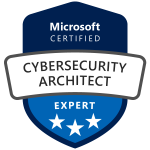MCE Cyber Security Architect Expert w/ MCA Microsoft Security Operations Analyst Associate ACCELERATED COMBO Training & Certification Boot Camp – 6 Days (2 Courses, 2 Exams, 2 Certs)
Training Schedule and Pricing
Our training model blends knowledge and certification prep into one solution. Interact face-to-face with vendor certified trainers AT OUR TRAINING CENTER IN SARASOTA, FL - OR - attend the same instructor-led live camp ONLINE.
-
May202024Delivery Format:CLASSROOM LIVEDate:05.20.2024 - 05.25.2024Location:SARASOTAPrice Includes:Instructor Led Class, Official Courseware, Labs and Exams$4,4956 days
-
Jun102024Delivery Format:CLASSROOM LIVEDate:06.10.2024 - 06.15.2024Location:SARASOTAPrice Includes:Instructor Led Class, Official Courseware, Labs and Exams$4,4956 days
-
Jul152024Delivery Format:CLASSROOM LIVEDate:07.15.2024 - 07.20.2024Location:SARASOTAPrice Includes:Instructor Led Class, Official Courseware, Labs and Exams$4,4956 days
What's Included
2 Microsoft Official Courses
2 Microsoft Test Vouchers
1 Retake Voucher (per exam, if needed)
Microsoft Official Labs
Onsite Pearson Vue Test Center
Instructor Led Live Training
The MCE Cyber Security Architect Expert w/ MCA Microsoft Security Operations Analyst Associate Training & Certification 6 Day Boot Camp covers a wide range of security engineering areas, including identity and access, platform protection, security operations, securing data, and securing applications.. This camp includes an essential Azure Foundations training to make sure students have an end-to-end understanding of Azure Administration.
The MCE Cyber Security Architect Expert w/ MCA Microsoft Security Operations Analyst Associate boot camp is taught using TWO Microsoft Official Courseware Courses
SC-100T00: Microsoft Cybersecurity Architect
SC-200T00: Microsoft Security Operations Analyst
While attending this 6 day camp - students will take two exams (SC-100 & SC-200) to achieve two certifications - MCE Cyber Security Architect Expert w/ MCA Microsoft Security Operations Analyst Associate certifications. This hands on, instructor led live camp teaches the knowledge to administer an Azure environment along with the knowledge needed for the certification exams which are administered while attending.
Skills Gained
Design a Zero Trust strategy and architecture
Evaluate Governance Risk Compliance (GRC) technical strategies and security operations strategies
Design security for infrastructure
Design a strategy for data and applications
Explain how Microsoft Defender for Endpoint can remediate risks in your environment
Administer a Microsoft Defender for Endpoint environment
Configure Attack Surface Reduction rules on Windows devices
Topics Covered in this Official Boot Camp
Build an overall security strategy and architecture
Learn how to build an overall security strategy and architecture.Lesson
- Introduction
- Zero Trust overview
- Develop Integration points in an architecture
- Develop security requirements based on business goals
- Translate security requirements into technical capabilities
- Design security for a resiliency strategy
- Design a security strategy for hybrid and multi-tenant environments
- Design technical and governance strategies for traffic filtering and segmentation
- Understand security for protocols
- Exercise: Build an overall security strategy and architecture
- Knowledge check
- Summary
After completing this module, students will be able to:
- Develop Integration points in an architecture
- Develop security requirements based on business goals
- Translate security requirements into technical capabilities
- Design security for a resiliency strategy
- Design security strategy for hybrid and multi-tenant environments
- Design technical and governance strategies for traffic filtering and segmentation
Design a security operations strategy
Learn how to design a security operations strategy.Lesson
- Introduction
- Understand security operations frameworks, processes, and procedures
- Design a logging and auditing security strategy
- Develop security operations for hybrid and multi-cloud environments
- Design a strategy for Security Information and Event Management (SIEM) and Security Orchestration,
- Evaluate security workflows
- Review security strategies for incident management
- Evaluate security operations strategy for sharing technical threat intelligence
- Monitor sources for insights on threats and mitigations
After completing this module, students will be able to:
- Design a logging and auditing security strategy
- Develop security operations for hybrid and multi-cloud environments.
- Design a strategy for Security Information and Event Management (SIEM) and Security Orchestration, A
- Evaluate security workflows.
- Review security strategies for incident management.
- Evaluate security operations for technical threat intelligence.
- Monitor sources for insights on threats and mitigations.
Design an identity security strategy
Learn how to design an identity security strategy.Lesson
- Introduction
- Secure access to cloud resources
- Recommend an identity store for security
- Recommend secure authentication and security authorization strategies
- Secure conditional access
- Design a strategy for role assignment and delegation
- Define Identity governance for access reviews and entitlement management
- Design a security strategy for privileged role access to infrastructure
- Design a security strategy for privileged activities
- Understand security for protocols
After completing this module, students will be able to:
- Recommend an identity store for security.
- Recommend secure authentication and security authorization strategies.
- Secure conditional access.
- Design a strategy for role assignment and delegation.
- Define Identity governance for access reviews and entitlement management.
- Design a security strategy for privileged role access to infrastructure.
- Design a security strategy for privileged access.
Evaluate a regulatory compliance strategy
Learn how to evaluate a regulatory compliance strategy.Lesson
- Introduction
- Interpret compliance requirements and their technical capabilities
- Evaluate infrastructure compliance by using Microsoft Defender for Cloud
- Interpret compliance scores and recommend actions to resolve issues or improve security
- Design and validate implementation of Azure Policy
- Design for data residency Requirements
- Translate privacy requirements into requirements for security solutions
After completing this module, students will be able to:
- Interpret compliance requirements and their technical capabilities
- Evaluate infrastructure compliance by using Microsoft Defender for Cloud
- Interpret compliance scores and recommend actions to resolve issues or improve security
- Design and validate implementation of Azure Policy
- Design for data residency requirements
- Translate privacy requirements into requirements for security solutions
Evaluate security posture and recommend technical strategies to manage risk
Learn how to evaluate security posture and recommend technical strategies to manage risk.Lesson
- Introduction
- Evaluate security postures by using benchmarks
- Evaluate security postures by using Microsoft Defender for Cloud
- Evaluate security postures by using Secure Scores
- Evaluate security hygiene of Cloud Workloads
- Design security for an Azure Landing Zone
- Interpret technical threat intelligence and recommend risk mitigations
- Recommend security capabilities or controls to mitigate identified risks
After completing this module, students will be able to:
- Evaluate security postures by using benchmarks
- Evaluate security postures by using Microsoft Defender for Cloud
- Evaluate security postures by using Secure Scores
- Evaluate security hygiene of Cloud Workloads
- Design security for an Azure Landing Zone
- Interpret technical threat intelligence and recommend risk mitigations
- Recommend security capabilities or controls to mitigate identified risks
Understand architecture best practices and how they are changing with the Cloud
Learn about architecture best practices and how they are changing with the Cloud.Lesson
- Introduction
- Plan and implement a security strategy across teams
- Establish a strategy and process for proactive and continuous evolution of a security strategy
- Understand network protocols and best practices for network segmentation and traffic filtering
After completing this module, students will be able to:
- Describe best practices for network segmentation and traffic filtering.
- Plan and implement a security strategy across teams.
- Establish a strategy and process for proactive and continuous evaluation of security strategy.
Desing a strategy for security server and client endpoints
Learn how to design a strategy for securing server and client endpoints.Lesson
- Introduction
- Specify security baselines for server and client endpoints
- Specify security requirements for servers
- Specify security requirements for mobile devices and clients
- Specify requirements for securing Active Directory Domain Services
- Design a strategy to manage secrets, keys, and certificates
- Design a strategy for secure remote access
- Understand security operations frameworks, processes, and procedures
- Understand deep forensics procedures by resource type
After completing this module, students will be able to:
- Specify security baselines for server and client endpoints
- Specify security requirements for servers
- Specify security requirements for mobile devices and clients
- Specify requirements for securing Active Directory Domain Services
- Design a strategy to manage secrets, keys, and certificates
- Design a strategy for secure remote access
- Understand security operations frameworks, processes, and procedures
- Understand deep forensics procedures by resource type
Design a strategy for securing PaaS, IaaS, and SaaS services
Learn how to design a strategy for securing PaaS, IaaS, and SaaS services.Lesson
- Introduction
- Specify security baselines for PaaS services
- Specify security baselines for IaaS services
- Specify security baselines for SaaS services
- Specify security requirements for IoT workloads
- Specify security requirements for data workloads
- Specify security requirements for web workloads
- Specify security requirements for storage workloads
- Specify security requirements for containers
- Specify security requirements for container orchestration
After completing this module, students will be able to:
- Specify security baselines for PaaS, SaaS and IaaS services
- Specify security requirements for IoT, data, storage, and web workloads
- Specify security requirements for containers and container orchestration
Specify security requirements for applications
Learn how to specify security requirements for applications.Lesson
- Introduction
- Understand application threat modeling
- Specify priorities for mitigating threats to applications
- Specify a security standard for onboarding a new application
- Specify a security strategy for applications and APIs
After completing this module, students will be able to:
- Specify priorities for mitigating threats to applications
- Specify a security standard for onboarding a new application
- Specify a security strategy for applications and APIs
Design a strategy for securing data
Learn how to design a strategy for securing data.Lesson
- Introduction
- Prioritize mitigating threats to data
- Design a strategy to identify and protect sensitive data
- Specify an encryption standard for data at rest and in motion
After completing this module, students will be able to:
- Prioritize mitigating threats to data
- Design a strategy to identify and protect sensitive data
- Specify an encryption standard for data at rest and in motion
Mitigate threats using Microsoft 35 Defender
Analyze threat data across domains and rapidly remediate threats with built-in orchestration and automation in Microsoft 365 Defender. Learn about cybersecurity threats and how the new threat protection tools from Microsoft protect your organization’s users, devices, and data. Use the advanced detection and remediation of identity-based threats to protect your Azure Active Directory identities and applications from compromise.Lesson
- Introduction to threat protection with Microsoft 365
- Mitigate incidents using Microsoft 365 Defender
- Remediate risks with Microsoft Defender for Office 365
- Microsoft Defender for Identity
- Protect your identities with Azure AD Identity Protection
- Microsoft Defender for Cloud Apps
- Respond to data loss prevention alerts using Microsoft 365
- Manage insider risk in Microsoft 365
Lab : Mitigate threats using Microsoft 365 Defender
- Explore Microsoft 365 Defender
After completing this module, students will be able to:
- Explain how the threat landscape is evolving
- Manage incidents in Microsoft 365 Defender
- Conduct advanced hunting in Microsoft 365 Defender
- Investigate alerts in Microsoft 365 Defender
- Describe the investigation and remediation features of Azure Active Directory Identity Protection
- Explain how Cloud Discovery helps you see what’s going on in your organization
Mitigate threats using MIcrosoft Defender Endpoint
Implement the Microsoft Defender for Endpoint platform to detect, investigate, and respond to advanced threats. Learn how Microsoft Defender for Endpoint can help your organization stay secure. Learn how to deploy the Microsoft Defender for Endpoint environment, including onboarding devices and configuring security. Learn how to investigate incidents and alerts using Microsoft Defender for Endpoint. Perform advanced hunting and consult with threat experts. You will also learn how to configure automation in Microsoft Defender for Endpoint by managing environmental settings. Lastly, you will learn about your environment’s weaknesses by using Threat and Vulnerability Management in Microsoft Defender for Endpoint.Lesson
- Protect against threats with Microsoft Defender for Endpoint
- Deploy the Microsoft Defender for Endpoint environment
- Implement Windows security enhancements
- Perform device investigations
- Perform actions on a device
- Perform evidence and entities investigations
- Configure and manage automation
- Configure for alerts and detections
- Utilize Threat and Vulnerability Management
Lab : Mitigate threats using Microsoft 365 Defender for Endpoint
- Deploy Microsoft Defender for Endpoint
- Mitigate Attacks using Defender for Endpoint
After completing this module, students will be able to:
- Define the capabilities of Microsoft Defender for Endpoint
- Configure Microsoft Defender for Endpoint environment settings
- Configure Attack Surface Reduction rules on Windows devices
- Describe device forensics information collected by Microsoft Defender for Endpoint
- Conduct forensics data collection using Microsoft Defender for Endpoint
- Investigate user accounts in Microsoft Defender for Endpoint
- Manage automation settings in Microsoft Defender for Endpoint
- Manage indicators in Microsoft Defender for Endpoint
- Describe Threat and Vulnerability Management in Microsoft Defender for Endpoint
Mitigate threats using Microsoft Defender for Cloud
Use Microsoft Defender for Cloud, for Azure, hybrid cloud, and on-premises workload protection and security. Learn the purpose of Microsoft Defender for Cloud and how to enable it. You will also learn about the protections and detections provided by Microsoft Defender for Cloud for each cloud workload. Learn how you can add Microsoft Defender for Cloud capabilities to your hybrid environment.Lesson
- Plan for cloud workload protections using Microsoft Defender for Cloud
- Workload protections in Microsoft Defender for Cloud
- Connect Azure assets to Microsoft Defender for Cloud
- Connect non-Azure resources to Microsoft Defender for Cloud
- Remediate security alerts using Microsoft Defender for Cloud
Lab : Mitigate threats using Microsoft Defender for Cloud
- Deploy Microsoft Defender for Cloud
- Mitigate Attacks with Microsoft Defender for Cloud
After completing this module, students will be able to:
- Describe Microsoft Defender for Cloud features
- Explain which workloads are protected by Microsoft Defender for Cloud
- Explain how Microsoft Defender for Cloud protections function
- Configure auto-provisioning in Microsoft Defender for Cloud
- Describe manual provisioning in Microsoft Defender for Cloud
- Connect non-Azure machines to Microsoft Defender for Cloud
- Describe alerts in Microsoft Defender for Cloud
- Remediate alerts in Microsoft Defender for Cloud
- Automate responses in Microsoft Defender for Cloud
Create queries for Microsoft Sentinel using Kusto Query Language (KQL)
Write Kusto Query Language (KQL) statements to query log data to perform detections, analysis, and reporting in Microsoft Sentinel. This module will focus on the most used operators. The example KQL statements will showcase security related table queries. KQL is the query language used to perform analysis on data to create analytics, workbooks, and perform hunting in Microsoft Sentinel. Learn how basic KQL statement structure provides the foundation to build more complex statements. Learn how to summarize and visualize data with a KQL statement provides the foundation to build detections in Microsoft Sentinel. Learn how to use the Kusto Query Language (KQL) to manipulate string data ingested from log sources.Lesson
- Construct KQL statements for Microsoft Sentinel
- Analyze query results using KQL
- Build multi-table statements using KQL
- Work with string data using KQL statements
Lab : Create queries for Microsoft Sentinel using Kusto Query Language (KQL)
- Create queries for Microsoft Sentinel using Kusto Query Language (KQL)
After completing this module, students will be able to:
- Construct KQL statements
- Search log files for security events using KQL
- Filter searches based on event time, severity, domain, and other relevant data using KQL
- Summarize data using KQL statements
- Render visualizations using KQL statements
- Extract data from unstructured string fields using KQL
- Extract data from structured string data using KQL
- Create Functions using KQL
Configure your MIcrosoft Sentinel environment
Get started with Microsoft Sentinel by properly configuring the Microsoft Sentinel workspace. Traditional security information and event management (SIEM) systems typically take a long time to set up and configure. They’re also not necessarily designed with cloud workloads in mind. Microsoft Sentinel enables you to start getting valuable security insights from your cloud and on-premises data quickly. This module helps you get started. Learn about the architecture of Microsoft Sentinel workspaces to ensure you configure your system to meet your organization’s security operations requirements. As a Security Operations Analyst, you must understand the tables, fields, and data ingested in your workspace. Learn how to query the most used data tables in Microsoft Sentinel.Lesson
- Introduction to Microsoft Sentinel
- Create and manage Microsoft Sentinel workspaces
- Query logs in Microsoft Sentinel
- Use watchlists in Microsoft Sentinel
- Utilize threat intelligence in Microsoft Sentinel
Lab : Configure your Microsoft Sentinel environment
- Configure your Microsoft Sentinel environment
After completing this module, students will be able to:
- Identify the various components and functionality of Microsoft Sentinel.
- Identify use cases where Microsoft Sentinel would be a good solution.
- Describe Microsoft Sentinel workspace architecture
- Install Microsoft Sentinel workspace
- Manage an Microsoft Sentinel workspace
- Create a watchlist in Microsoft Sentinel
- Use KQL to access the watchlist in Microsoft Sentinel
- Manage threat indicators in Microsoft Sentinel
- Use KQL to access threat indicators in Microsoft Sentinel
Connect logs to Microsoft Sentinel
Connect data at cloud scale across all users, devices, applications, and infrastructure, both on-premises and in multiple clouds to Microsoft Sentinel. The primary approach to connect log data is using the Microsoft Sentinel provided data connectors. This module provides an overview of the available data connectors. You will get to learn about the configuration options and data provided by Microsoft Sentinel connectors for Microsoft 365 Defender.Lesson
- Connect data to Microsoft Sentinel using data connectors
- Connect Microsoft services to Microsoft Sentinel
- Connect Microsoft 365 Defender to Microsoft Sentinel
- Connect Windows hosts to Microsoft Sentinel
- Connect Common Event Format logs to Microsoft Sentinel
- Connect syslog data sources to Microsoft Sentinel
- Connect threat indicators to Microsoft Sentinel
Lab : Connect logs to Microsoft Sentinel
- Connect data to Microsoft Sentinel using data connectors
- Connect Windows devices to Microsoft Sentinel using data connectors
- Connect Linux hosts to Microsoft Sentinel using data connectors
- Connect Threat intelligence to Microsoft Sentinel using data connectors
After completing this module, students will be able to:
- Explain the use of data connectors in Microsoft Sentinel
- Explain the Common Event Format and Syslog connector differences in Microsoft Sentinel
- Connect Microsoft service connectors
- Explain how connectors auto-create incidents in Microsoft Sentinel
- Activate the Microsoft 365 Defender connector in Microsoft Sentinel
- Connect Azure Windows Virtual Machines to Microsoft Sentinel
- Connect non-Azure Windows hosts to Microsoft Sentinel
- Configure Log Analytics agent to collect Sysmon events
- Explain the Common Event Format connector deployment options in Microsoft Sentinel
- Configure the TAXII connector in Microsoft Sentinel
- View threat indicators in Microsoft Sentinel
Create detections and perform investigations using Microsoft Sentinel
Detect previously uncovered threats and rapidly remediate threats with built-in orchestration and automation in Microsoft Sentinel. You will learn how to create Microsoft Sentinel playbooks to respond to security threats. You’ll investigate Microsoft Sentinel incident management, learn about Microsoft Sentinel events and entities, and discover ways to resolve incidents. You will also learn how to query, visualize, and monitor data in Microsoft Sentinel.Lesson
- Threat detection with Microsoft Sentinel analytics
- Security incident management in Microsoft Sentinel
- Threat response with Microsoft Sentinel playbooks
- User and entity behavior analytics in Microsoft Sentinel
- Query, visualize, and monitor data in Microsoft Sentinel
Lab : Create detections and perform investigations using Microsoft Sentinel
- Activate a Microsoft Security rule
- Create a Playbook
- Create a Scheduled Query
- Understand Detection Modeling
- Conduct attacks
- Create detections
- Investigate incidents
- Create workbooks
After completing this module, students will be able to:
- Explain the importance of Microsoft Sentinel analytics.
- Create rules from templates.
- Manage rules with modifications.
- Explain Microsoft Sentinel SOAR capabilities.
- Create a playbook to automate an incident response.
- Investigate and manage incident resolution.
- Explain User and Entity Behavior Analytics in Microsoft Sentinel
- Explore entities in Microsoft Sentinel
- Visualize security data using Microsoft Sentinel workbooks.
Perform threat hunting in Microsoft Sentinel
In this module, you’ll learn to proactively identify threat behaviors by using Microsoft Sentinel queries. You’ll also learn to use bookmarks and livestream to hunt threats. You will also learn how to use notebooks in Microsoft Sentinel for advanced hunting.Lesson
- Threat hunting concepts in Microsoft Sentinel
- Threat hunting with Microsoft Sentinel
- Hunt for threats using notebooks in Microsoft Sentinel
Lab : Threat hunting in Microsoft Sentinel
- Perform threat hunting in Microsoft Sentinel
- Threat hunting using notebooks with Microsoft Sentinel
After completing this module, students will be able to:
- Describe threat hunting concepts for use with Microsoft Sentinel
- Define a threat hunting hypothesis for use in Microsoft Sentinel
- Use queries to hunt for threats.
- Observe threats over time with livestream.
- Explore API libraries for advanced threat hunting in Microsoft Sentinel
- Create and use notebooks in Microsoft Sentinel
CERTIFICATION CAMPS FACILITIES
CAMPUS - Certification Camps built out a stand alone training center (not a hotel conference room) with spacious classrooms, new desk, Herman Miller Aeron chairs & comfortable common areas. Each student has a dedicated desk with two monitors. Each classroom has a maximum of two rows - so everyone is able to be engaged without the "back row" feeling.
CLASSROOM EQUIPMENT - Students work on a dedicated Dell Client Desktop with 32GB memory with 512GB SSD drives - All Labs are executed the extremely fast Microsoft Data Center Hosted Lab Environment .
CAMPUS INTERNET - The campus is connected with a 1Gbps (1,000 Mbps) Verizon Fios Business Connection which provides complete internet (including VPN) access for students.
COMMON AREA - Amenties including snacks, drinks (Coffee, 100% juices, sodas, etc) all complimentary.
LODGING - We use the Hyatt Place Lakewood Ranch. This "upgraded" hotel offers extremely comfortable beds, great breakfast and very fast internet access.
NEAR BY - Many shops, restaurants and grocery options are available within walking distance. Additionally - the hotel provided scheduled shuttle services. Restaurants like Cheesecake Factory, California Pizza Kitchen, Panera Bread, Bone Fish Grill, Ruby Tuesday's, Five Guys, Chipotle, Chili's and over 20 additional choices in the immediate area.












